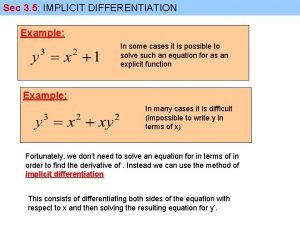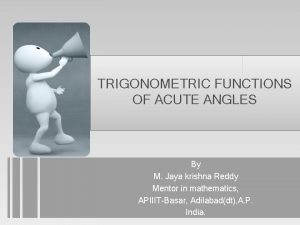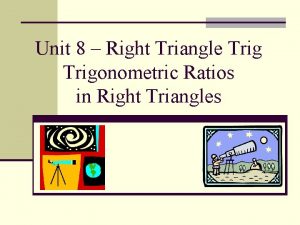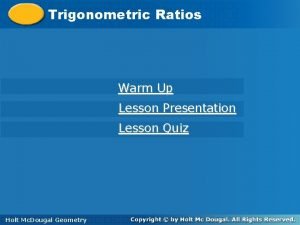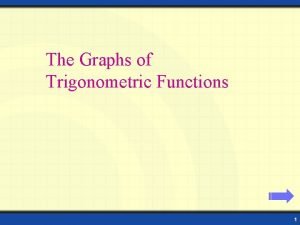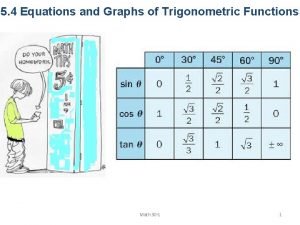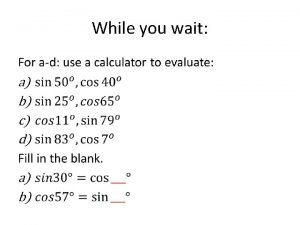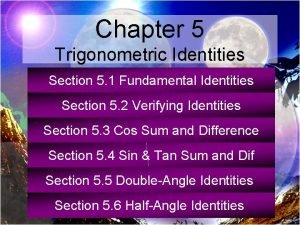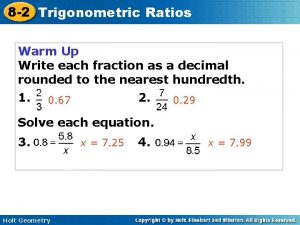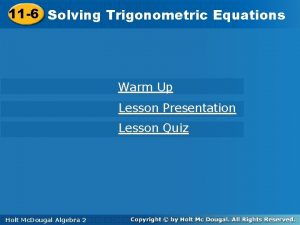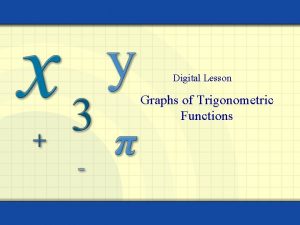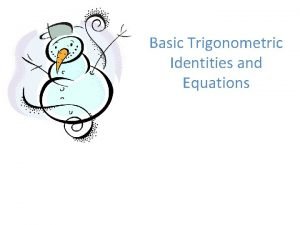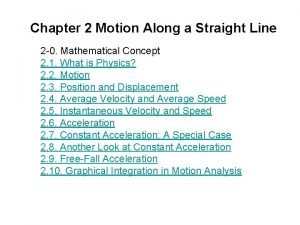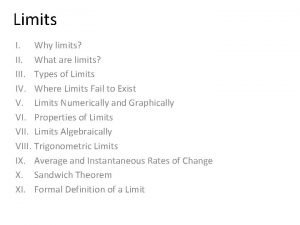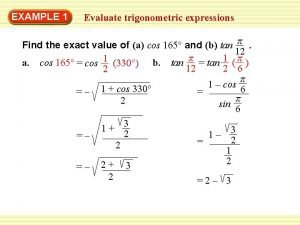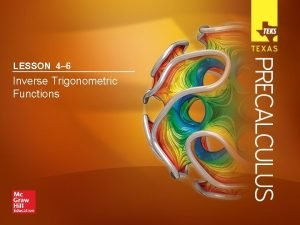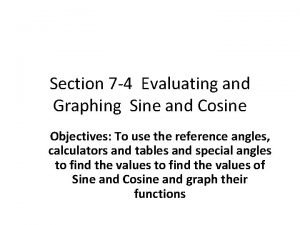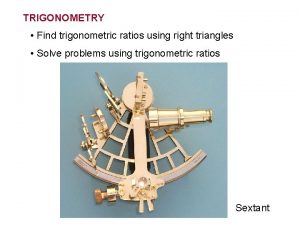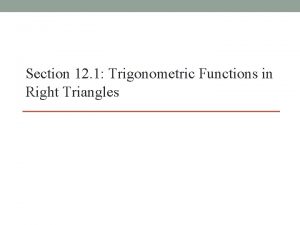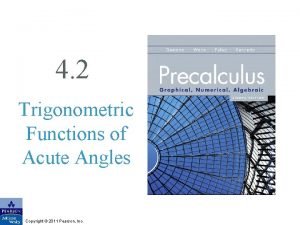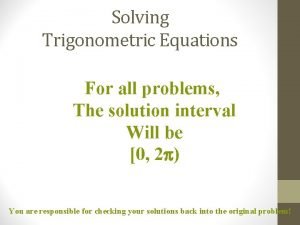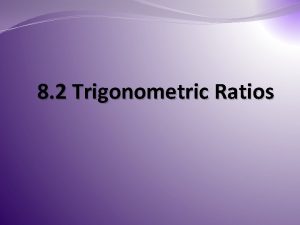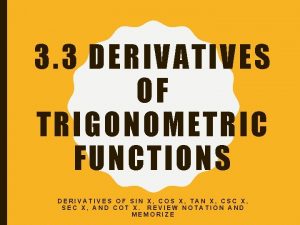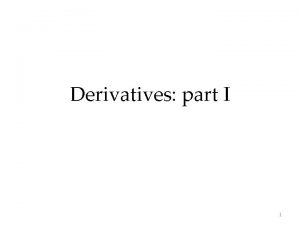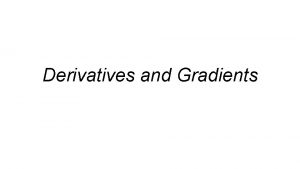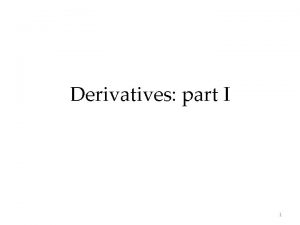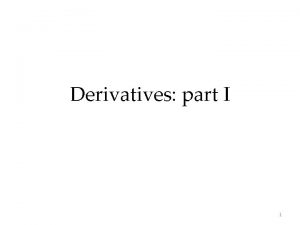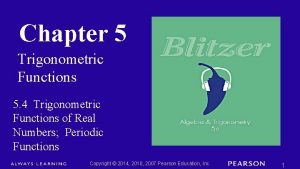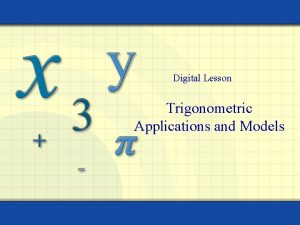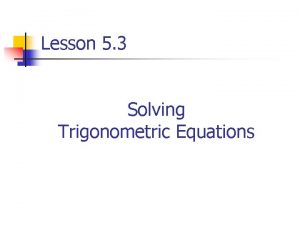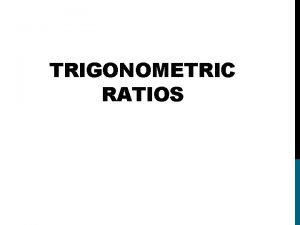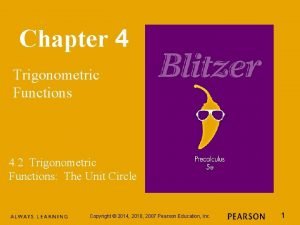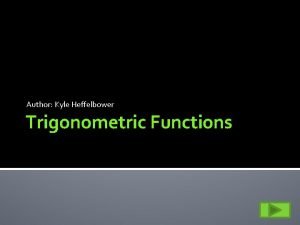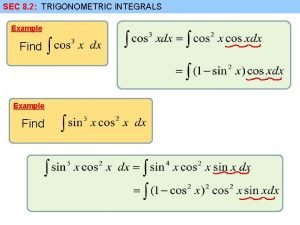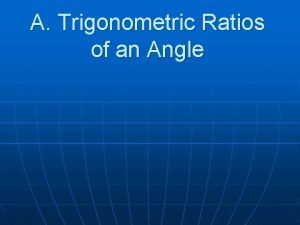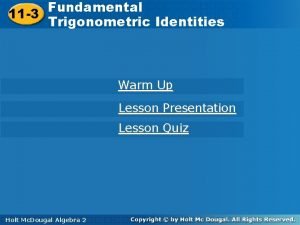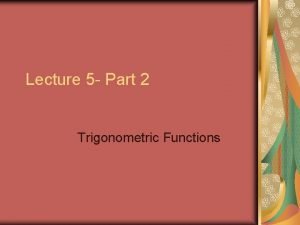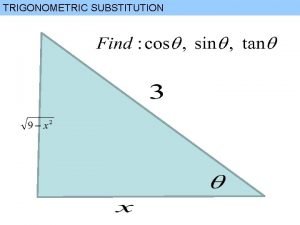3 DERIVATIVES DERIVATIVES 3 4 Derivatives of Trigonometric



























- Slides: 27

3 DERIVATIVES

DERIVATIVES 3. 4 Derivatives of Trigonometric Functions In this section, we will learn about: Derivatives of trigonometric functions and their applications.

DERIVATIVES OF TRIGONOMETRIC FUNCTIONS Let’s sketch the graph of the function f(x) = sin x and use the interpretation of f’(x) as the slope of the tangent to the sine curve in order to sketch the graph of f’.

DERIVATIVES OF TRIGONOMETRIC FUNCTIONS Then, it looks as if the graph of f’ may be the same as the cosine curve.

DERIV. OF SINE FUNCTION Formula 4 So, we know the formula for the derivative of the sine function:

DERIVS. OF TRIG. FUNCTIONS Example 1 Differentiate y = x 2 sin x. § Using the Product Rule and Formula 4, we have:

DERIV. OF COSINE FUNCTION Formula 5 Using the same methods as in the proof of Formula 4, we can prove:

DERIV. OF TANGENT FUNCTION The tangent function can also be differentiated by using the definition of a derivative. However, it is easier to use the Quotient Rule together with Formulas 4 and 5—as follows.

DERIV. OF TANGENT FUNCTION Formula 6

DERIVS. OF TRIG. FUNCTIONS The derivatives of the remaining trigonometric functions—csc, sec, and cot— can also be found easily using the Quotient Rule.

DERIVS. OF TRIG. FUNCTIONS We have collected all the differentiation formulas for trigonometric functions here. § Remember, they are valid only when x is measured in radians.

DERIVS. OF TRIG. FUNCTIONS Example 2 Differentiate For what values of x does the graph of f have a horizontal tangent?

DERIVS. OF TRIG. FUNCTIONS The Quotient Rule gives: Example 2

DERIVS. OF TRIG. FUNCTIONS Example 2 In simplifying the answer, we have used the identity tan 2 x + 1 = sec 2 x.

DERIVS. OF TRIG. FUNCTIONS Example 2 Since sec x is never 0, we see that f’(x) when tan x = 1. § This occurs when x = nπ + π/4, where n is an integer.

APPLICATIONS Trigonometric functions are often used in modeling real-world phenomena. § In particular, vibrations, waves, elastic motions, and other quantities that vary in a periodic manner can be described using trigonometric functions. § In the following example, we discuss an instance of simple harmonic motion.

APPLICATIONS Example 3 An object at the end of a vertical spring is stretched 4 cm beyond its rest position and released at time t = 0. § In the figure, note that the downward direction is positive. § Its position at time t is s = f(t) = 4 cos t § Find the velocity and acceleration at time t and use them to analyze the motion of the object.

APPLICATIONS Example 3 The velocity and acceleration are:

APPLICATIONS Example 3 The object oscillates from the lowest point (s = 4 cm) to the highest point (s = -4 cm). The period of the oscillation is 2π, the period of cos t.

APPLICATIONS Example 3 The speed is |v| = 4|sin t|, which is greatest when |sin t| = 1, that is, when cos t = 0. § So, the object moves fastest as it passes through its equilibrium position (s = 0). § Its speed is 0 when sin t = 0, that is, at the high and low points.

APPLICATIONS Example 3 The acceleration a = -4 cos t = 0 when s = 0. It has greatest magnitude at the high and low points.

DERIVS. OF TRIG. FUNCTIONS Example 4 Find the 27 th derivative of cos x. § The first few derivatives of f(x) = cos x are as follows:

DERIVS. OF TRIG. FUNCTIONS Example 4 § We see that the successive derivatives occur in a cycle of length 4 and, in particular, f (n)(x) = cos x whenever n is a multiple of 4. § Therefore, f (24)(x) = cos x § Differentiating three more times, we have: f (27)(x) = sin x

DERIVS. OF TRIG. FUNCTIONS Our main use for the limit in Equation 2 has been to prove the differentiation formula for the sine function. § However, this limit is also useful in finding certain other trigonometric limits—as the following two examples show.

DERIVS. OF TRIG. FUNCTIONS Example 5 Find § In order to apply Equation 2, we first rewrite the function by multiplying and dividing by 7:

DERIVS. OF TRIG. FUNCTIONS Example 5 If we let θ = 7 x, then θ → 0 as x → 0. So, by Equation 2, we have:

Example 6 DERIVS. OF TRIG. FUNCTIONS Calculate . § We divide the numerator and denominator by x: by the continuity of cosine and Eqn. 2
 Cosx-sinx formula
Cosx-sinx formula Implicit differentation
Implicit differentation Trig limits
Trig limits Trigonometric ratios of the angles
Trigonometric ratios of the angles Trigonometric functions right triangle
Trigonometric functions right triangle Trigonometric ratios quiz
Trigonometric ratios quiz Trigonometric function properties
Trigonometric function properties Trig graph equation
Trig graph equation Trigonometric form to rectangular form
Trigonometric form to rectangular form Pythagorean identites
Pythagorean identites 5-1 trigonometric identities
5-1 trigonometric identities Lesson 8-2 trigonometric ratios
Lesson 8-2 trigonometric ratios Solving linear trigonometric equations
Solving linear trigonometric equations Intro to trigonometry worksheet
Intro to trigonometry worksheet Trigonometric functions
Trigonometric functions Reciprocal identities
Reciprocal identities 13-4 inverses of trigonometric functions answers
13-4 inverses of trigonometric functions answers Trigonometric functions
Trigonometric functions Limits of trigonometric functions
Limits of trigonometric functions Simplify the following trigonometric expression
Simplify the following trigonometric expression Evaluating trigonometric expressions
Evaluating trigonometric expressions Graphing systems of linear inequalities maze answer key
Graphing systems of linear inequalities maze answer key Lesson 4 the sine function
Lesson 4 the sine function Trigonometry graph
Trigonometry graph Trigonometric ratios in right triangles
Trigonometric ratios in right triangles 12-1 trigonometric functions in right triangles
12-1 trigonometric functions in right triangles Six trig functions
Six trig functions Trig equations
Trig equations

